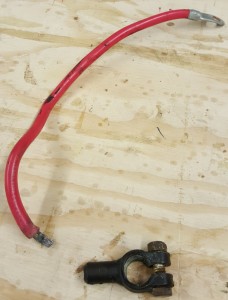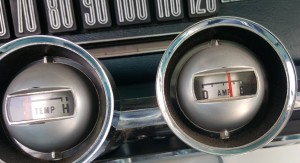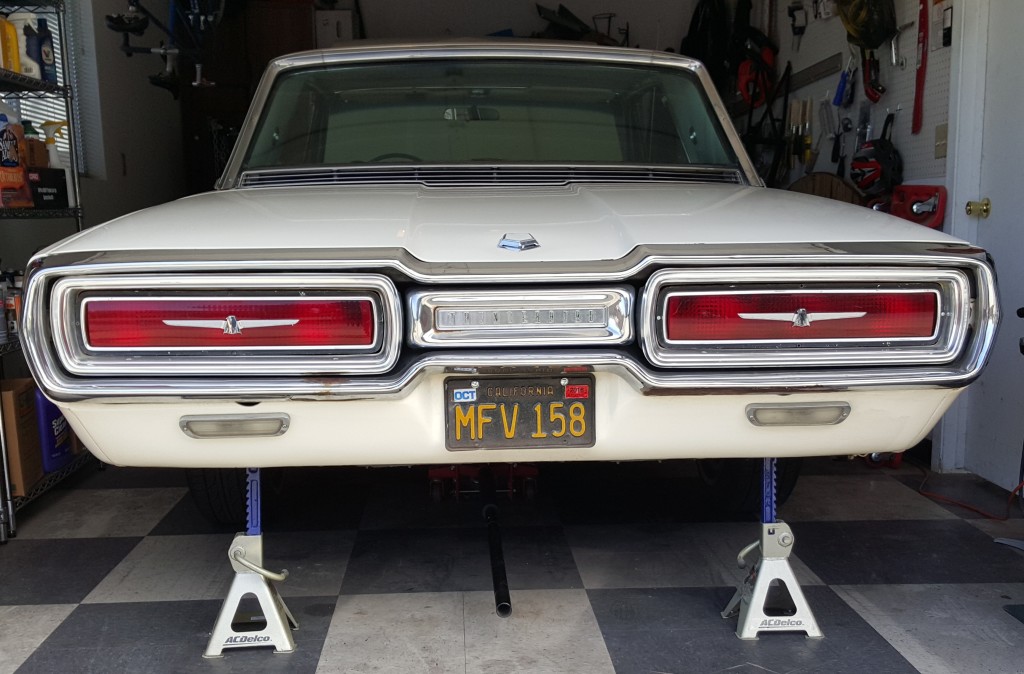
It only took a few minutes to swap out the old positive battery cable, despite the limited access on the solenoid side of things. After I removed it, I was able to pull the old cable right out of the fitting by hand, so it had clearly gone south.
The good news is that the car started fine. I drove it across town on a few errands. In the beginning, the only oddity was the Amp gauge swung way over on the charge side—where it stayed the entire time.
Sad to say, though, the engine stumble (which I thought might be related to the battery connection) was just as bad, if not worse, than before. I had trouble holding speed on the freeway (especially when the engine was hot), and on a cruise through the countryside, any acceleration or load on the motor was met with a cough and sputter.

Back home, I could see that there was a lot of air in the fuel line, so I suspect a failing fuel pump—probably the 4th or 5th I’ve gone through. I’ll get a replacement on order.
With the pump issue sidelining the T-Bird, I put it up on jackstands so I can replace the bushings in the rear springs. By a stroke of luck, while looking for my jackstands(misplaced when I moved), I found the studs I need to get the phenolic spacer back under the carburetor.

So—I’ve got a bit of work ahead of me: springs, pump and carburertor. With summer fast approaching (It was almost 80º here today!) I’ll need to move quickly.

Your stumbling and inability to maintain speed reminds me of the time I had a similar issue. Turns out the points were barely opening, giving me a very weak spark. Having recently replaced them I was quite surprised. The plastic/nylon piece that rides on the distributor cam had worn down significantly decreasing the point gap. Of course loss of fuel pressure on demand could also be the culprit. I just rebuilt my pump too, but for a different reason. It was spewing oil out the vent holes on top of the housing. It’s an original style AC pump I wanted to keep using for sake of originality so I bought a rebuild kit for it. Upon disassembly I noticed the oil seal around the diaphragm actuating rod was dislodged from the pump housing, allowing oil to be sucked up and out the vent holes during operation
I’m running an electronic distributor, so it’s not a problem with points, for certain, though I haven’t ruled out the possibility that the dizzy is failing, too. Sadly, my pump is the newer, crimped style–rebuilding: not an option.
Where your amp needle is is where mine is all the time. Where is the needle normally? Change out your alternator for a new one with different output, and the needle does a new arbitrary dance. Personally, I think these old ammeter assemblies are leftover parts from the 40’s.
Normally my amp gauge sits right in the middle, especially at speed. With the engine near idle, it dances all over the place. In this case, it was rock steady on the “C” side the entire time. You’re right that the ’64 amp gauge is bad from every angle. I wish there was a period-looking replacement volt meter out there–I would swap it out in a heartbeat.
Thank you for this blog. I live in Sweden z d own a 64. I’ve learned a lot about these cars from your posts, especially about the steering column. Keep them posts coming!